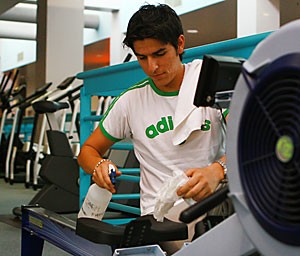The assailant lurked in hospitals, confined to sanctum-white hallways, clinging to bed sheets and gowns and preying on nurses and patients already incapacitated by sickness.
It was a problem students didn’t think about until late 2004, and now Campus Health Service reports an average of three cases per week.
The culprit is methicillin-resistant Staphylococcus aureus, a bacterial strain that can cause severe infection if left untreated. Most physicians refer it to as MRSA (pronounced MUR-suh).
“”We never saw it in prior to 2004,”” said Lisette LeCorgne, a nurse practitioner and coordinator of urgent care at Campus Health.
“”Now, lots of people are ‘colonized,'”” said LeCorgne, and it’s impossible to guess how it “”got out”” of hospitals, where the infection was common.
The bacterium affects student athletes across the nation, as well as students who frequent the gym.
MRSA is a bacterium many people can carry on their skin, and it is harmless until it finds a way into the body, through a cut or a razor burn or by sharing towels and other personal items, said LeCorgne.
Vote Now!
Where on campus has the most bacteria?
Randy Cohen, a Arizona Athletics trainer, said MRSA infections are commonplace with contact sports like football, rugby or wrestling, but as long as patients catch it early and get treatment, it doesn’t become a problem.
Any time a player reports anything that looks like a spider bite or a skin irritation, the first thing to check for is MRSA.
“”It looks like a bug bite or a zit and can be very painful,”” said Cohen. “”You have to treat it correctly and early.””
Cohen said in the six years he has been with the athletics program, there have been many infections but no outbreaks.
“”The main thing to prevent (MRSA) is education,”” Cohen said. “”We tell the players not to share towels, razors or any personal items. And any time you have an open wound, cover it.””
In addition to educating the staff and athletes, preventative cleaning measures are also taken.
“”The key issue is maintaining clean environments in the locker rooms,”” said Cohen.
Special detergents are used to wash towels and jerseys in 140- to 160-degree water. The Student Recreation Center could also be a haven for the bacterium, but there have not been any reported cases since MRSA became prevalent.
“”Fortunately, knock on wood, we haven’t had any staph infections in the time I’ve been here,”” said Mark Zakrzewski, assistant director of fitness.
The bottles of disinfectant sitting by the paper towel machines in the Rec Center contain bactericides to kill MRSA, and patrons are encouraged to spray down their equipment after use, said Zakrzewski.
Early recognition is key because if left untreated, the bacterium can cause staph infections and lead to pneumonia, blood infections or in some cases, death, according to the U.S. Centers for Disease Control.
Cohen said he worries about club sports, because they often lack proper precautions and facilities.
Dr. Nathan Conlee, the UA rugby club team doctor, said no cases have been reported to him.
An outbreak can decimate an entire team, added Cohen.
One of the first such outbreaks was in 2003, when 11 University of Southern California football players were diagnosed with MRSA and six were hospitalized.
A football player at Lycoming College in Pennsylvania died the same year from complications resulting from late diagnosis of a MRSA infection.
Normally, treatment is simple and the problem can usually be cured by taking a pill called Bactrim two times a day for 10 days.
But that’s only if you catch it early, otherwise intravenous medication may be necessary, said LeCorgne.
“”If it’s dark, dark red or painful at all,”” she said, “”come in for treatment.””









